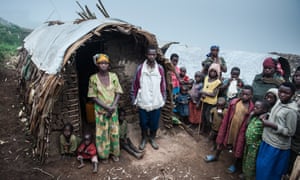Conflict, violence and natural disasters forced more than 31 million people to leave home and settle elsewhere within their countries last year, the equivalent of one person every second.
But while the number of people uprooted by conflict outnumbers refugees by two to one, they have been largely ignored by the international community, according to a report by the Norwegian Refugee Council’s Internal Displacement Monitoring Centre.
Alexandra Bilak, director of the IDMC, said that while resources had rightly been devoted to the refugee crisis, scant attention had been paid to people forced to resettle. “Not including internal displacement as an integral part of that entire displacement and migration picture is very shortsighted, because by looking only at the point of arrival and not considering where those journeys started, inevitably you’re missing part of the picture,” she said.
“If you redirect attention to the countries of origin and to really understanding the driving forces of these movements it would be a much more strategic approach and investment,” added Bilak.
Last year, an estimated 6.9 million people were forced to leave their homes as a result of conflict and violence. Worst affected was the Democratic Republic of the Congo, where 922,000 were displaced, a 50% rise on the previous year. Close behind was Syria (824,000), followed by Iraq (659,000), Afghanistan (653,000), Nigeria (501,000) and Yemen (478,000).
Disasters such as floods, storms and wildfires had an even greater effect, displacing 24.2 million people, more than three times the number uprooted by conflict. This trend was at its most acute in east Asia and the Pacific. In China, 7.4 million were forced from their homes, with 5.9 million affected in the Philippines and a further 2.4 million in India. Floods accounted for half of all people displaced by disasters.
In some cases, a complex mix of conflict and disaster has forced communities from their homes, the report’s authors noted. It pointed to the situations unfolding in Nigeria, South Sudan and Somalia, where drought combined with conflict and violence are fuelling displacement, severe food insecurity and famine.
Bilak said the number of displacements due to violence in DRC was proof that the underlying conflicts cannot be ignored. “Unless the crisis and the factors that lead to this crisis are addressed they will re-erupt on a cyclical basis.”
In May last year, the UN proposed (pdf) that governments commit to reducing the number of internally displaced people by at least 50% by 2030. The report warned this is little more than an aspiration, however.
Last year, more aid was spent on refugee resettlement within donor nations than in the countries where displacement crises originated.
******************************************************************************
“What we focus on is the symptom of this breakdown of protection and human rights of people in their local communities. We just focus on the symptom, which is the people we see at our borders,” said Jan Egeland, secretary general of the Norwegian Refugee Council.
He said there is a link with refugees – though the vast majority of displaced people do not have the opportunity or means to cross borders.
Six of the 10 countries that produced the most refugees in 2015 – Afghanistan, Colombia, DRC, South Sudan and Syria – were also among the 10 with the largest number of internally displaced people.
Egeland warned that without political intervention the situation will only get worse.
“First, conflict resolution needs to be redoubled, tripled, quadrupled,” he said. “It’s incredible there’s not a bigger pull towards a peaceful settlement of the Yemeni conflict. We also need to get economic life to countries like Yemen and elsewhere so there’s not a collapse in social structures there. Then we need investment in avoiding environmental degradation, and we need disaster risk reduction.”






